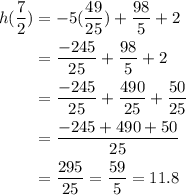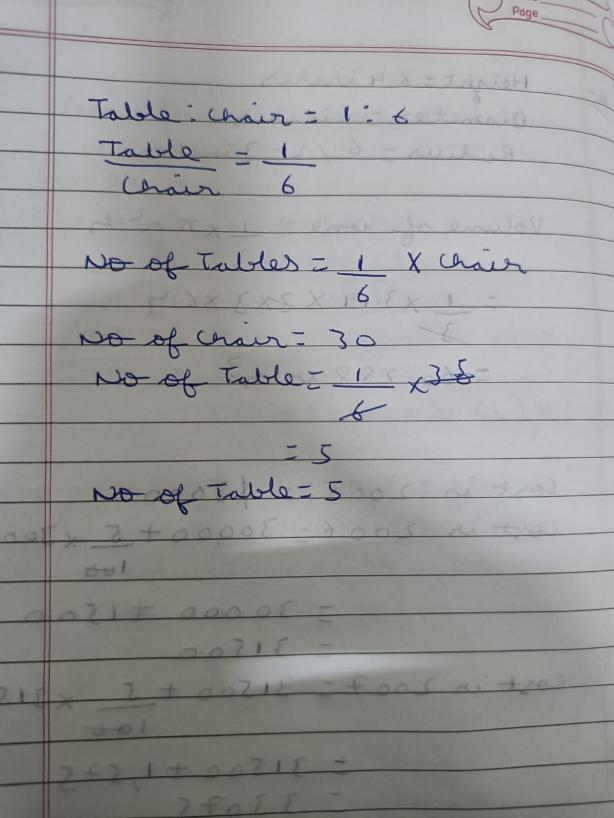 3
3 Hello,
This is a parabola.
The vertex is for x= 15/2*5=3/2, and then the maximum is reached for

As 85/4 < 24 the ball does not reach a height of 24 m
thanks
 11
11 Part A)
No
Part B)
About 2.9362 seconds.
Step-by-step explanation:
The equation  models the height h in meters of the ball t seconds after its launch.
models the height h in meters of the ball t seconds after its launch.
Part A)
To determine whether or not the ball reaches a height of 14 meters, we can find the vertex of our function.
Remember that the vertex marks the maximum value of the quadratic (since our quadratic curves down).
If our vertex is greater than 14, then, at some time t, the ball will definitely reach a height of 14 meters.
However, if our vertex is less than 14, then the ball doesn’t reach a height of 14 meters since it can’t go higher than the vertex.
So, let’s find our vertex. The formula for vertex is given by:

Our quadratic is:

Hence: a=-5, b=14, and c=2.
Therefore, the x-coordinate of our vertex is:

To find the y-coordinate and the maximum height, we will substitute this value back in for x and evaluate. Hence:

Evaluate:

So, our maximum value is 11.8 meters.
Therefore, the ball doesn’t reach a height of 14 meters.
Part B)
To find out how long the ball is in the air, we can simply solve for our t when h=0.
When the ball stops being in the air, this will be the point at which it is at the ground. So, h=0. Therefore:

A quick check of factors will reveal that is it not factorable. Hence, we can use the quadratic formula:

Again, a=-5, b=14, and c=2. Substitute appropriately:

Evaluate:

We can factor the square root:

Hence:

Divide everything by -2:

Hence, our two solutions are:

Since our variable indicates time, we can reject the negative solution since time cannot be negative.
Hence, our zero is approximately 2.9362.
Therefore, the ball is in the air for approximately 2.9362 seconds.
 3
3 Hello,
This is a parabola.
The vertex is for x= 15/2*5=3/2, and then the maximum is reached for

As 85/4 < 24 the ball does not reach a height of 24 m
thanks
 11
11 Part A)
No
Part B)
About 2.9362 seconds.
Step-by-step explanation:
The equation  models the height h in meters of the ball t seconds after its launch.
models the height h in meters of the ball t seconds after its launch.
Part A)
To determine whether or not the ball reaches a height of 14 meters, we can find the vertex of our function.
Remember that the vertex marks the maximum value of the quadratic (since our quadratic curves down).
If our vertex is greater than 14, then, at some time t, the ball will definitely reach a height of 14 meters.
However, if our vertex is less than 14, then the ball doesn’t reach a height of 14 meters since it can’t go higher than the vertex.
So, let’s find our vertex. The formula for vertex is given by:

Our quadratic is:

Hence: a=-5, b=14, and c=2.
Therefore, the x-coordinate of our vertex is:

To find the y-coordinate and the maximum height, we will substitute this value back in for x and evaluate. Hence:

Evaluate:

So, our maximum value is 11.8 meters.
Therefore, the ball doesn’t reach a height of 14 meters.
Part B)
To find out how long the ball is in the air, we can simply solve for our t when h=0.
When the ball stops being in the air, this will be the point at which it is at the ground. So, h=0. Therefore:

A quick check of factors will reveal that is it not factorable. Hence, we can use the quadratic formula:

Again, a=-5, b=14, and c=2. Substitute appropriately:

Evaluate:

We can factor the square root:

Hence:

Divide everything by -2:

Hence, our two solutions are:

Since our variable indicates time, we can reject the negative solution since time cannot be negative.
Hence, our zero is approximately 2.9362.
Therefore, the ball is in the air for approximately 2.9362 seconds.
 15
15 A)  =0
=0
B)t= 0.45 seconds or t= 3.5 seconds
If time is greater than 0.45 seconds then ball will reach height 12m and higher.
Step-by-step explanation:
Given Equation:
h(t)= ------------------------------(Equation 1)
------------------------------(Equation 1)
a) Equation to tell if ball reaches height of 12m . for that :
h= 12m
put in Equation 1.
12 = 
or  =12
=12
or  -12 = 0
-12 = 0
 =0
=0
or  = 0 -----------------------------------(Equation 2)
= 0 -----------------------------------(Equation 2)
This Equation tells if ball reaches height of 12m
b) Does ball reaches height of 12m :
For that, the value of time can be found out from the equation above,
 = 0
= 0
It can be solved using the quadratic formula:


t= 0.45 seconds or t= 3.5 seconds
If time is greater than 0.45 seconds then ball will reach height 12m and higher.
The correct option is;
D. -8·t² + 18·t + 6 = 10
Step-by-step explanation:
The given equation of the height toy cannon launched on top of a platform is given as follows;
h(t) = -8·t² + 18·t + 6...(1)
Where "h" represents the height in meters, at time "t" seconds after the ball is launched
When the height is 10 meters, we can write as follows;
The height of the ball, h(t) = 10
Therefore, by substituting the value of h(t) in equation (1), h(t) = -8·t² + 18·t + 6, when h(t) = 10 we get;
-8·t² + 18·t + 6 = 10.
The correct option is;
D. -8·t² + 18·t + 6 = 10
Step-by-step explanation:
The given equation of the height toy cannon launched on top of a platform is given as follows;
h(t) = -8·t² + 18·t + 6...(1)
Where "h" represents the height in meters, at time "t" seconds after the ball is launched
When the height is 10 meters, we can write as follows;
The height of the ball, h(t) = 10
Therefore, by substituting the value of h(t) in equation (1), h(t) = -8·t² + 18·t + 6, when h(t) = 10 we get;
-8·t² + 18·t + 6 = 10.
The total nom of code that can be used is equal to 5+3 = 8
The solution is in the following image


It will provide an instant answer!
